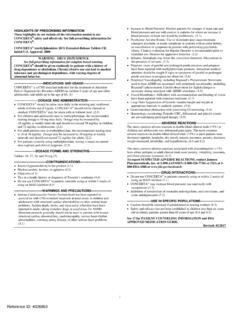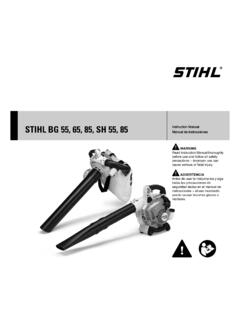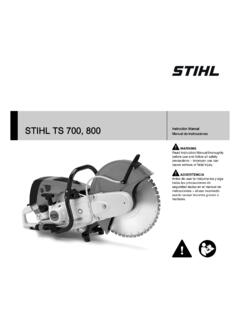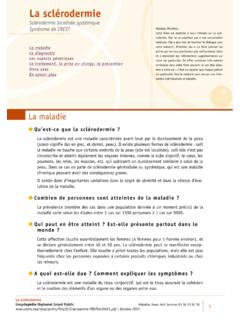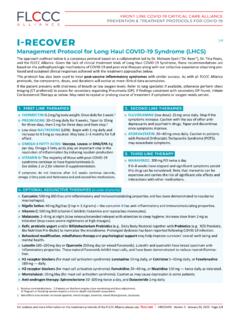Transcription of Stimulant and Related Medications: Use in Adults
1 Stimulant and Related Medications: Use in AdultsOctober 2015 The Centers for Medicare & Medicaid Services (CMS) Medicaid Integrity Group (MIG) has identified issues with the utilization of Stimulant and Related medications. The Food and Drug Administration (FDA) approves product labeling for prescription drugs. The MIG has identified that some providers may have prescribed Stimulant and Related medications outside of FDA-approved product labeling for indication, age, dosage, or duration of therapy. Therefore, CMS goal is to improve quality of care and enhance patient safety by educating providers on the proper use of Stimulant and Related medications in Adults . This fact sheet summarizes the current FDA-approved product labeling for the use of Stimulant and Related medications in Adults . After reading this fact sheet, providers should be able to accurately: Identify the FDA-approved indications for the use of Stimulant and Related medications in Adults ; Identify the available treatment options for attention-deficit/hyperactivity disorder (ADHD) and narcolepsy in Adults ; and Summarize the adverse reactions and risks of Stimulant and Related Indications for Stimulant and Related Medications in AdultsStimulant and Related medications are FDA approved for the treatment of ADHD, narcolepsy, exogenous obesity (a body mass index [BMI] of 30 or higher[1]), binge eating disorder (BED),[2] and as adjunct therapy for obstructive sleep apnea.
2 However, not all of these medications are FDA approved for each indication. They are most often used by Adults for the treatment of ADHD or narcolepsy. Stimulant and Related Medications: Use in Adults2 Diagnosing Attention-Deficit/Hyperactivity Disorder in AdultsThe diagnostic criteria in the Diagnostic and Statistical Manual of Mental Disorders, Fifth Edition, (DSM-5) contain an updated definition of ADHD and symptoms required to diagnose affected children and Adults . The criteria for the diagnosis of ADHD can be found at on the Centers for Disease Control and Prevention (CDC) website.[3]Symptoms of diagnosed or undiagnosed ADHD can continue from childhood to adulthood.[4] Thus, Adults presenting with suspected ADHD need to be evaluated for the presence of symptoms since childhood. Symptoms of inattention, hyperactivity, or impulsivity must have been present by age 12 to diagnose ADHD. According to the DSM-5 criteria, a proper diagnosis also requires that symptoms be present in two or more settings: work, home, school, or social environments.
3 [5] Providers should be aware that the 2015 updates to most ADHD drug labels still reference DSM-4 criteria, and they should consider the updated DSM-5 criteria the current for the Treatment of Attention-Deficit/Hyperactivity Disorder in AdultsStimulant medications have been the mainstay of treatment for ADHD since the late 1930s.[6] Atomoxetine is a nonstimulant medication that is FDA approved for the treatment of ADHD. FDA-Approved Indications and DosagesSeveral dosage formulations of Stimulant medications are not FDA approved for use in Adults . There are also some nonstimulant medications approved to treat ADHD only in pediatric patients, such as extended-release guanfacine and extended-release clonidine. As a result, FDA-approved treatment options are more limited for Adults diagnosed with ADHD. The FDA-approved dosages and indications for the use of stimulants and Related medications in Adults are provided in the document Stimulant and Related Medications: Food and Drug Administration-Approved Indications and Dosages for Use in Adults Available at on the CMS attention-deficit/hyperactivity disorderAHRQ Agency for Healthcare Research and QualityBED binge eating disorder BMI body mass indexCDC Centers for Disease Control and PreventionCDER Center for Drug Evaluation and ResearchCMS Centers for Medicare & Medicaid ServicesDRESS drug rash with eosinophilia and systemic symptomsDSM-4 Diagnostic and Statistical Manual of Mental Disorders, Fourth Edition DSM-5 Diagnostic and Statistical Manual of Mental Disorders, Fifth EditionFDA Food and Drug AdministrationMIG Medicaid Integrity GroupMPIE Medicaid Program Integrity EducationOTC over the counterStimulant and Related Medications.
4 Use in Adults3 Stimulant MedicationsThe exact mechanism by which Stimulant medications exert their effects in ADHD is unknown. Stimulant medications are thought to work by increasing the neurotransmission of dopamine and norepinephrine.[7, 8] Stimulant medications come in multiple dosage forms and strengths that are equally effective in the treatment of ADHD; however, individual patient response may vary.[9]Treatment may be initiated with either a short-acting or long-acting Stimulant medication . The short-acting Stimulant medications may be easily titrated to dosages that produce symptom relief with manageable adverse reactions. However, adherence to treatment plans may improve with the use of a long-acting Stimulant was the first and remains the only nonstimulant approved by the FDA for the treatment of ADHD in Adults [10] and is an option for patients who cannot take a Stimulant medication . It inhibits presynaptic norepinephrine transport, which is thought to be the mechanism responsible for the therapeutic effects in ADHD, and studies have shown it is superior to placebo in the treatment of ADHD.
5 Atomoxetine is not a controlled substance, so it has a lower potential for substance abuse. It also has a long duration of action, which allows for once-a-day dosing.[11]Treatment Guidelines for the Use of Stimulants and Related Medications in AdultsThe Agency for Healthcare Research and Quality (AHRQ) hosts a database of treatment guidelines. The AHRQ is a branch of the Department of Health and Human Services. For information on the available treatment guidelines, search stimulants or any of the conditions for which a Stimulant or Related medication is an indicated treatment in the AHRQ s National Guideline Clearinghouse at on the Internet. Links to some of the guidelines that provide information on the use of Stimulant and Related medications in Adults are provided in Table 1. Treatment Guidelines for the Use of Stimulant and Related Medications in AdultsSponsoring OrganizationTitle of GuidelineLink to GuidelineEuropean Federation of Neurological SocietiesManagement of narcolepsy in Adults .
6 [2011] Institute for Health and Clinical Excellence Attention deficit hyperactivity disorder. Diagnosis and management of ADHD in children, young people and Adults . [2013] and Related Medications: Use in Adults4 Adverse Reactions and Risks of the Use of Stimulant and Related Medications in AdultsStimulant and Related medications are generally well tolerated. The most common adverse reactions to Stimulant and Related medications are loss of appetite, upset stomach, insomnia, and headache.[12, 13, 14] Increases in heart rate and blood pressure have also been seen as a result of the sympathomimetic properties of Stimulant medications. These cardiovascular effects have also been reported with atomoxetine.[15]Cardiovascular Risks with Stimulant Medications and with AtomoxetineSudden death, stroke, and myocardial infarction have been reported with Stimulant medications and with atomoxetine. Patients should have a medical history and physical exam conducted prior to the initiation of therapy to assess cardiac disease, including family history of sudden cardiac death, family history of ventricular arrhythmia, or structural cardiac abnormalities.
7 Patients with preexisting cardiac conditions should avoid the use of Stimulant medications and the use of atomoxetine The manufacturers of Stimulant and Related medications recommend a cardiac evaluation for any patient who presents with cardiac symptoms.[16, 17]The FDA and AHRQ sponsored a study on the cardiovascular risks associated with ADHD medications in children and young Adults (2 to 24 years old). More than million patient records were evaluated. Results showed no association between the use of Stimulant medications and adverse cardiovascular events. However, the FDA encourages periodic monitoring of heart rate and blood pressure and encourages avoiding the use of Stimulant medications in patients with serious heart problems. Two more studies in Adults are being reviewed to evaluate the risk of cardiovascular events with Stimulant medications.[18, 19]In 2007, the FDA instructed the manufacturers of medications approved for the treatment of ADHD to develop medication Guides to be dispensed with every new or refilled prescription.
8 The medication Guides inform patients, families, and caregivers about the possible cardiovascular risks and precautions that they may take to minimize the risks. The medication Guides were recently updated to include information regarding circulatory problems.[20]Peripheral Vasculopathy, Including raynaud s PhenomenonIn June 2013, the FDA published MedWatch drug safety labeling changes as a result of postmarketing reports of circulatory problems in fingers and toes associated with Stimulant medications and atomoxetine. The FDA recommends instructing patients who are beginning treatment with these medications about the risks of peripheral vasculopathy, including raynaud s phenomenon and the associated signs and symptoms. The medication Guides have been revised to include this drug safety information as well.[21]Risk of Priapism with Methylphenidate ProductsIn December 2013, the FDA published a Drug Safety Communication to warn that methylphenidate-containing products may cause priapism in pediatric and adult patients.
9 Events occurred most frequently in patients on established drug therapy undergoing dose escalation, but were also reported during withdrawal periods (drug holidays or discontinuation). The FDA cautions individuals who experience abnormally sustained or frequent and painful erections to seek immediate medical attention.[22] Stimulant and Related Medications: Use in Adults5 Rhabdomyolysis with Stimulant DrugsIn April 2015, the FDA required all Stimulant manufacturers to add rhabdomyolysis to the Adverse Reactions section of the respective drugs prescribing information. Rhabdomyolysis is the breakdown of muscle tissue, which is then released into the blood stream. This can cause kidney damage. Symptoms include dark, red, or cola-colored urine, decreased urine output, general weakness, and various muscle problems, including stiffness, aching, and tenderness.[23, 24]Risk of Psychiatric Adverse EventsAn FDA review of Stimulant medications showed an increase in the risk of medication - Related psychiatric events, such as hearing voices or experiencing mania.
10 The previously mentioned medication Guides also inform patients, families, and caregivers about the risks of adverse psychiatric symptoms associated with Stimulant and Related medications.[25]Abuse and Misuse of Stimulant Medications Stimulant medications have significant abuse potential. Prescribing information warns of the high potential for abuse and also warns that extended use may lead to drug dependence. Stimulant medications with an FDA-approved indication should only be taken by patients for whom they have been prescribed.[26] A boxed warning has been added to Stimulant medications due to their high potential for dependence and boxed warning for amphetamine and amphetamine derivatives states:[27]WARNING: POTENTIAL FOR ABUSEA mphetamines have a high potential for abuse. Administration of amphetamines for prolonged periods of time may lead to drug dependence. Pay particular attention to the possibility of subjects obtaining amphetamines for nontherapeutic use or distribution to others and the drugs should be prescribed or dispensed sparingly [see DRUG ABUSE AND DEPENDENCE (9)].










